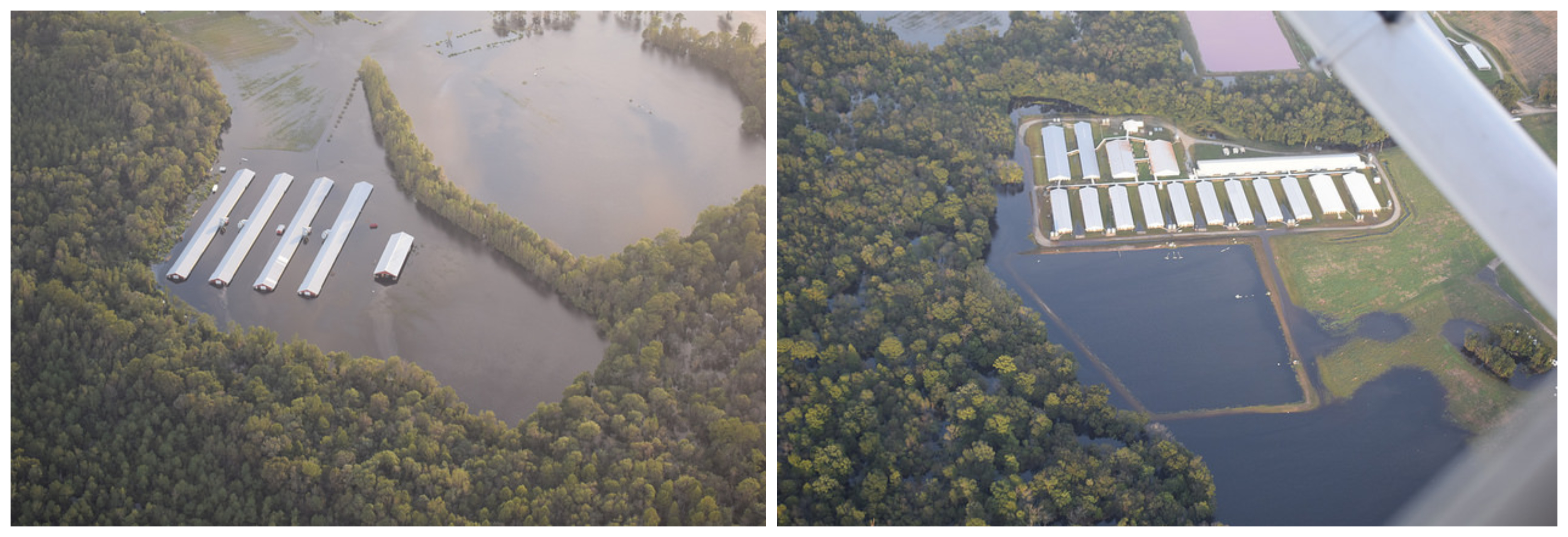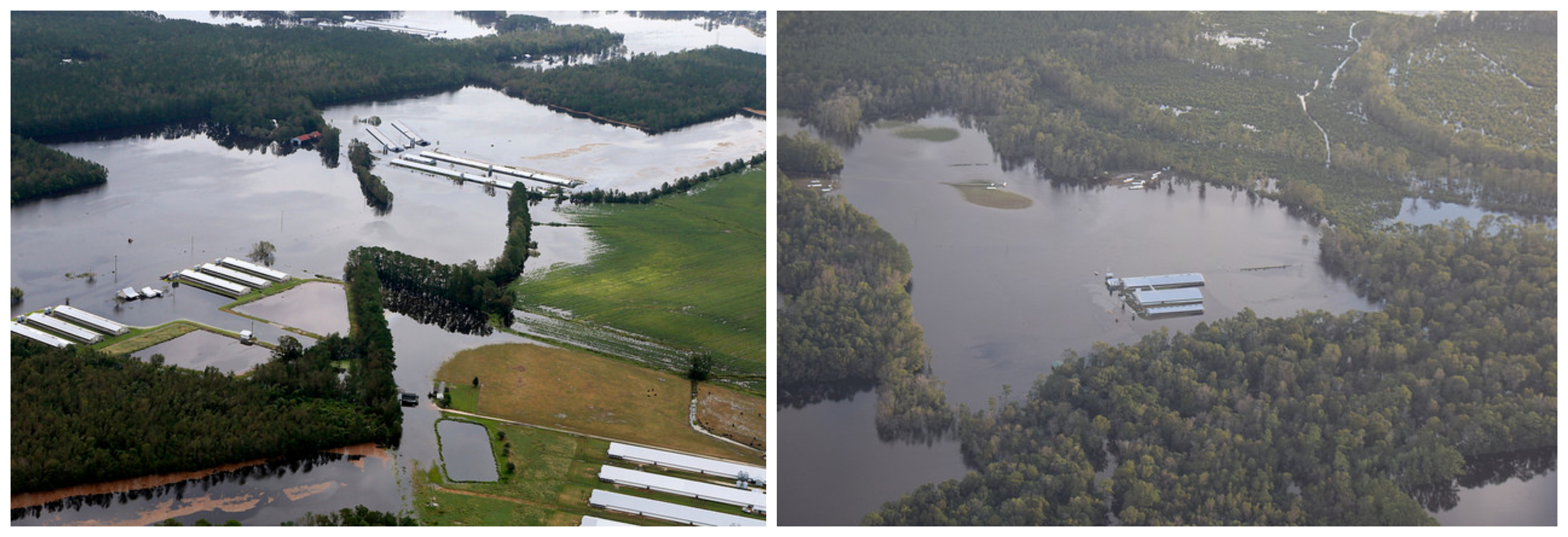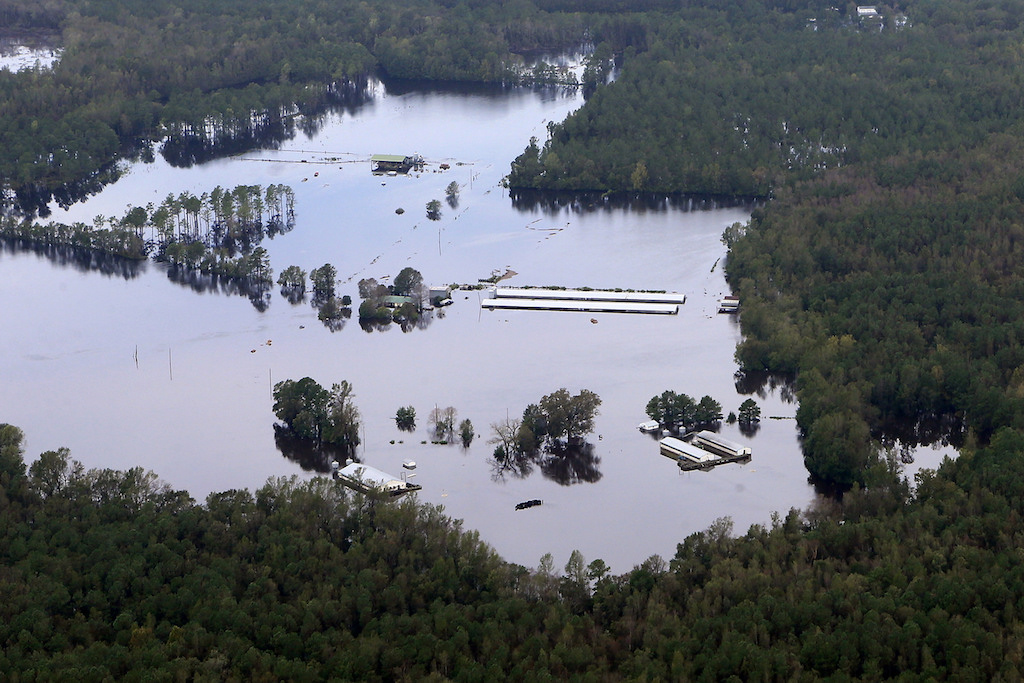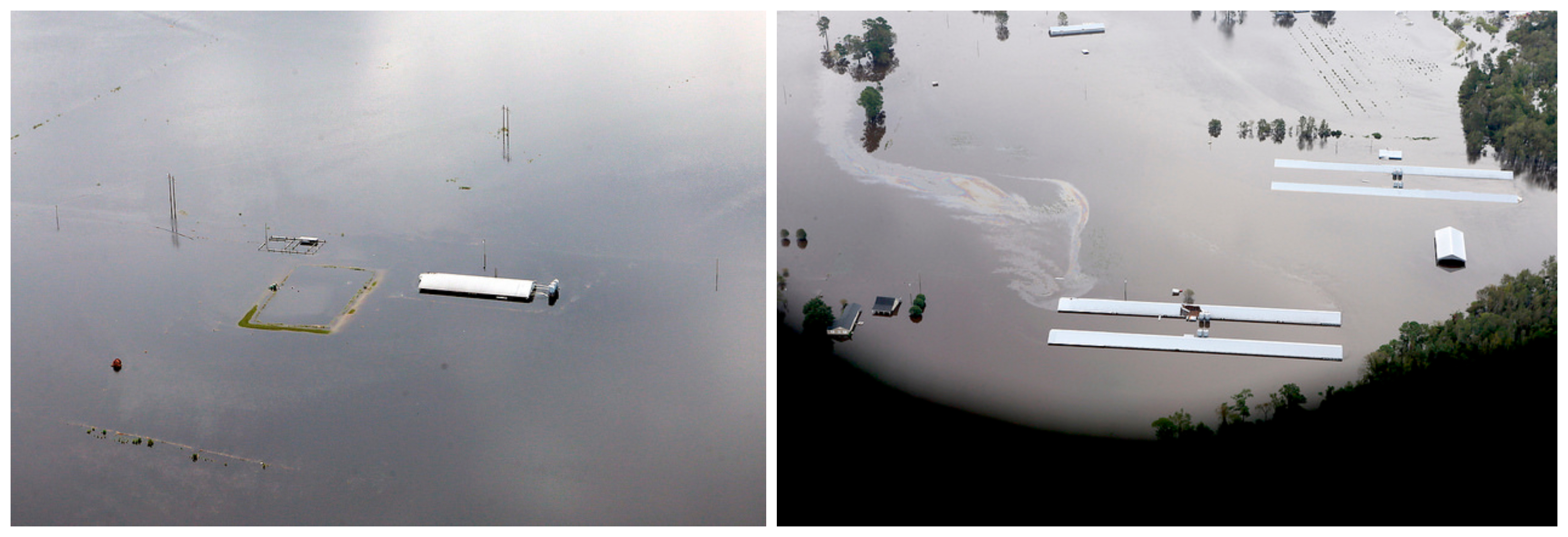New Food Economy: In North Carolina, losses of nearly 2 million birds and 26 flooded lagoons reported
by H. Claire Brown | September 18th, 2018
Aerial photos show livestock operations in various stages of inundation. Here’s what you need to know about this developing story.
By Tuesday afternoon, the remains of Hurricane Florence had migrated up to New England, tapering off as the clouds prepared to drift from the East Coast into the Atlantic. Meanwhile, as the rain slowed to a halt in the Carolinas, residents were just beginning to grasp the full scope of the storm’s damage.
Even as blue skies peek through the clouds, homes and farms near major rivers aren’t fully in the clear. Some water bodies, swollen from days of rain, are expected to crest later in the week before they empty into the ocean.
Photographers on Monday began telegraphing aerial footage of the flooding to media outlets on the ground. Drone imagery showed parts of highway I-95 completely submerged, and some photographers captured images of beachfront homes, intact on their stilts, with nothing but a stretch of moving water beyond the front door.
The state’s farms, too, are taking stock of the storm’s impact on their operations. On Monday, representatives from environmental advocacy group Waterkeeper flew over affected farmland and published images of inundated farms and coal ash pits online.

Waterkeeper Alliance
Above are two aerial photographs of farms in Trenton, North Carolina. On the right is a hog farm
Sanderson Farms, a poultry integrator headquartered in Laurel, Mississippi, announced its farmers had lost an estimated 1.7 million birds in the storm “because of flash floods,” said Mike Cockrell, the company’s treasurer and CFO, when reached by phone on Tuesday afternoon. “We had done everything we could possibly imagine ahead of the storm, but at the end of the day, there was no way to stop the water.” Integrators provide feed and birds to farmers who act as independent contractors, and farmers ultimately sell full-grown broilers back to Sanderson. “We will also continue to pay [the farmer] as if he were still raising chickens for us. Even though it’s going to take him six months or longer to get his house back up and running, we will continue to pay him his average pay, as much as he’s made in the past year, so he can meet his obligations,” said Cockrell.
The North Carolina Pork Council on Tuesday afternoon counted one breached hog waste lagoon, three farms whose lagoons withstood structural damage, nine that were inundated, and 13 “overtopped,” meaning the contents of the lagoon will or have spilled out. That’s a total of 26 damaged lagoons, though the degree of waste that spills from each will certainly vary.
Here’s a quick backgrounder on the spillage terminology: “Breaches” and “structural damages” mean the walls of the lagoons have failed, making way for waste to spill into floodwater. This is the worst of the four post-storm scenarios, because it means “untold gallons of waste and sludge can spill into floodwaters,” according to Michelle Nowlin, an environmental lawyer at Duke University. “Inundation” means that the walls remain intact, but floodwater washes into the lagoons and mixes with the hog waste. According to the Council, the resulting contaminated water is “heavily diluted,” though some of the wastewater does mix with the rainwater. “Overtopping” happens when heavy rainfall causes a lagoon to overflow, spilling out into the floodwaters. According Nowlin, all four scenarios involve fecal coliform bacteria and excessive nutrients spilling out into surrounding waters, “contributing to a bad situation.”

Waterkeeper Alliance
Photographed above is a farm in Island Creek in Duplin County (left) and a farm in the town of Trenton in Jones County (right)
Florence’s impact on livestock operations is already worse than the damage inflicted by Hurricane Matthew in 2016, which inundated 14 lagoons and only breached one on an inactive farm. The numbers may continue to climb as river levels rise and farmers report more damage.
The poultry industry, too, is still hovering at the intersection between rescue and recovery. Margaret Ross is a poultry specialist at North Carolina State University. She works with farmers in 33 counties, though she’s been struggling to reach them because cellular service has been intermittent. She and her husband operate a farm in Pollocksville, an area she’s lived in all her life. “I’ve never seen anything like it,” she says. “It’s absolutely heartbreaking. I feel like I’m in a daze.”
Ross says it’s impossible to tell precisely how many chickens have been lost in the eastern part of the state. “The areas that I have been in contact with are still completely flooded and they do not have a way to check in on the soundness of the farm at this time except by boat,” she says, adding that some of her colleagues at the university are assisting with farmer outreach.
Right now, Ross is working with farmers to report their losses to the North Carolina Department of Agriculture and Consumer Services (NCDACS). As soon as the waters recede, they will have to find a way to dispose of their birds. Farmers, integrators, and NCDACS will work together to figure out the best way to handle all that waste. During Hurricane Matthew, the Federal Emergency Management Administration (FEMA) supplied wood chips and other supplies to aid in composting. Ross says some landfills accept poultry carcasses as well, though they may fill up.
Ross points out that North Carolina’s livestock industries have been through it all before, most recently in 2016. Still, it’s never easy for a farmer to bury his chickens. “They’re obviously sad,” Ross says. “They’ve lost their livelihoods, they’ve obviously lost their birds.”

